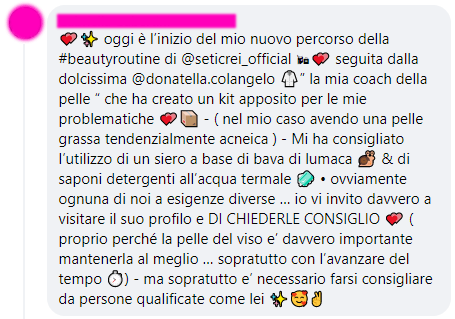How to recognize your skin type
"You have no idea how many people think they have a certain skin type and instead they have another skin type." This obviously carries over into the wrong beauty routine they use for their skin.
Published July 31, 2021 - Video Transcript.
Hello everyone!"
Today we are going to talk about the various epidermal types. The first step we need to take in order to learn to listen to what our skin is really telling us every day is to learn what kind of skin we have: this is of fundamental importance in order to choose the beauty routine that is right for us.
We can divide skins into five macro categories: normal, dry, sensitive, combination and oily skin.
Normal skin is a balanced skin, without imperfections, with fine pores, soft, smooth, with an even color (the skin I always wanted).
Dry skin is thin, inelastic, flaky and dehydrated skin. The skin seeks in turn can be:
- dehydrated and that is devoid of water, and presents itself with a dilated pore and blackheads;
- alipidic and that is devoid of sebum, thin that is easily marked and obviously without blackheads.
Or dehydrated and alipidic, where the characteristics of both variants coexist.
Sensitive skin is a fragile skin, hyperactive to chemical and physical agents, which is easily reddened by temperature changes, and may have red spots in the cheek area (this issue is called couperose).
Mixed skin is skin that has dry areas, normally the cheek area, and areas with oily skin normally the so-called T-zone (forehead, nose, and chin).
Oily skin is a skin with a thick grain, enlarged pores, shiny due to a sebaceous overproduction, pale with the presence of acne.
Up to here it would all seem very simple, but unfortunately there is nothing simple.
You have no idea how many people I meet in the private consultations I do who think they have one particular skin type and instead have another.
This obviously carries over into the wrong beauty routine they use for their skin.
Why is this so common? For two reasons. The first is that often one skin has multiple issues that coexist - I'll give you a very practical example. I have oily skin, but also very sensitive skin, so how would my skin be categorized? Oily skin or sensitive skin? And consequently, what would be the best beauty routine for my skin type? The one for oily skin? The one for sensitive skin? Or a mix of both?
The second reason, not least, is that our skin every day can be different, for multiple reasons: hormone, stress, heat, cold, humidity, what we eat, if we don't sleep, lifestyle changes... and so every morning we have to deal with what our skin is telling us at that terminus.
Think about the introduction of masks, how it changed our skins.
We started hearing about mask acne and this was generated because in light of an external change - the use of the mask causing a suffocation of the skin organ - we did not change our beauty routine and the skin, which cannot speak, through the appearance of furuncles even on dry epidermal types, communicated to us that something of what we were doing on her had to be changed.And could all this epidermal discomfort have been avoided? Certainly, all we had to do was listen to our skin and realize that she was sweating and not breathing under the mask, so we needed to lighten up our daily beautin routine or even change it.
But this was not done by the vast majority of people, because we are not in the habit of giving the right importance to this extraordinary organ called skin, but only when we have a problem then we start to listen to it.
How many times do I hear my clients say this phrase: "I have to keep changing cosmetics because otherwise the skin gets used to them and doesn't improve anymore". This is absolutely not true, on the contrary: do you know why you have to keep changing cosmetic products? For two reasons: because you don't listen to your skin, you rely on external advice, so you are often not satisfied with what you are using, and therefore you keep changing.
But mostly because to get satisfactory results you have to use a personalized beauty routine, tailored to you, and not what is trivially advertised more.
So you understand how important it is for me to train you to be able to interpret what your skin is telling you every day.
I didn't use the term "train" by chance, because my role as skin coach will be of great support to you only if combined with your ability to interpret what your skin is telling you.
But first of all you have to want the change, it has to start from you: listening to your takes also means understanding if a cosmetic product you are using is suitable or not for your skin type or problematic.
In the first episode of this channel I told you that at the beginning of my journey I was using propaedeutic cosmetic products for my problem but I was seeing my skin getting worse: and that's why I started to analyze that indecipherable language called INCI - International Nomenclature of Cosmetic Ingredients.
Trying to understand what a cosmetic product contains is the first step toward becoming more aware of what our skin is telling us.
Next episode will be entirely dedicated to explaining the INCI and its interpretation - a hug to all, see you next time!
What they say about us



















